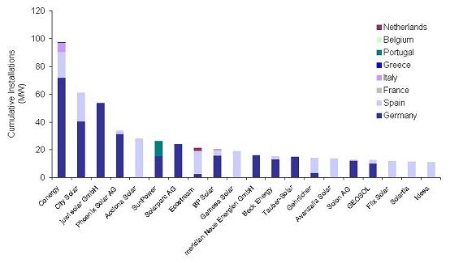
Solar PV Builds Momentum Across Europe
 |
| Photo Credit: Emerging Energy Research |
Jul 24, 2008 - renewableenergyworld.com
After years of being labeled a German phenomenon, the
solar photovoltaic (PV) sector is building momentum across
Europe, particularly in Spain. Catalyzed by newly adopted
feed-in tariffs, PV development activity in Europe is booming
and project size is scaling - causing shifts in competitive
positioning along the project development value chain, according
to a recent study from Emerging Energy Research, a leading
research and advisory firm analyzing clean and renewable
energy markets.
After years of dominating the solar PV industry, Germany
has been joined by Spain's scaling market and together the
two countries are setting the pace for PV development. Spain,
Europe's fastest growing PV market, is forecasted to install
800 MW in 2008 and grow to 5.6 GW by 2012, according to
EER. With long-term and relatively stable incentive regimes
in place, total installed grid-connected PV capacity in
Germany and Spain amounted to 1,440 MW in 2007, accounting
for 92% of the 1,562 MW installed in Europe.
| "As the solar PV industry
landscape adapts to lucrative feed-in tariffs, new markets,
and supply chain bottlenecks, participants are beginning
to target segments along the value chain that can leverage
their core capabilities in manufacturing, system integration,
and project ownership," says EER senior analyst Reese
Tisdale. |
Together, six countries--Germany, Spain, Italy, Greece,
France, and Portugal--are expected to hold the lion's share
of PV development activity over the coming years by adding
22 GW from 2008 through 2012, according to EER. But the
establishment of high feed-in tariffs in emerging markets,
including the Czech Republic, Bulgaria, and Switzerland
has set off a wave of PV development activity. Developers
are now positioning for first-mover advantage to establish
operations in these emerging PV markets, according to EER.
"The European solar PV market is becoming increasingly
fragmented across the value chain from manufacturers to
project owners with installers and developers operating
in the continuum," according to EER senior analyst Reese
Tisdale. Emerging PV-based power producers range from leading
renewables utilities to specialized solar PV plant owners
looking to gain market share. "As the industry landscape
adapts to lucrative feed-in tariffs, new markets, and supply
chain bottlenecks, participants are beginning to target
segments along the value chain that can leverage their core
capabilities in manufacturing, system integration, and project
ownership," says Tisdale.
German Developers Look to Southern Europe for PV Development
With several markets emerging simultaneously and a new
focus on Southern Europe, German project developers and
investors are expanding their activities beyond their home
market to compete in the larger European landscape, according
to EER's study. These players must navigate local permitting
and feed-in tariff regulations, develop local capabilities,
and finance new levels of growth. Leveraging their development
experience in the German market and existing vendor relationships,
leading German developers including Conergy, City Solar,
and Phoenix Solar are now entering Spain, Italy and other
Southern European markets to take advantage of feed-in tariff
incentives.
Leading European utilities--including EDF-EN, Iberdrola,
Electrabel, Enel, and Edison--have become increasingly interested
in PV. "Given their existing contacts with commercial and
industrial clients, and a proven appetite for renewables,
European utilities are well-positioned to enter the PV generation
market as the sector transitions toward rooftop installations,"
says Tisdale. Independent power producers, led by Acciona
Solar and AES, are looking to continue expanding their renewable
portfolios to include solar PV moving beyond wind, solar
CSP, small hydro power, and biomass.
An emerging group of specialized solar PV power plant producers
are also aiming to capture the fruits of their development
efforts. These players include Idesa, Renewagy, Solarparc,
SunEdison, and S.A.G. Solarstrom. "While the European PV
market remains extremely fragmented, in terms of plant construction
and plant ownership, emerging players are positioning themselves
to be specialized solar IPPs alongside larger renewable
players like Acciona or AES," says Tisdale. "For the most
part, their strategies leverage their long track record
gained in their home markets, secure module supply, and
access to capital through financing partners."
Supply Chain Challenges Scaling PV Market
On the supply side, the pace of technology change and a
global shortage in silicon supply have together presented
significant challenges to PV project developers and integrators,
according to EER's study. New technologies, such as thin
film, are driving costs downward and undercutting the traditional
silicon based module suppliers.
"The downside of rapid growth--typical of such a quickly
scaling industry--has been the supply chain's inability
to keep pace with demand," says Tisdale. As a result, developers
across the value chain have been pressured to secure not
only their existing positions but also to switch to less
efficient--but less expensive--technology (e.g. thin film),
to move toward vertical integration, or to lock in long-term
supply agreements to compete more effectively. "To survive
the currently evolving market environment, developers' nimbleness
will be critical to their ability to keep up with solar
PV's increasingly frenetic pace," says Tisdale.
ABOUT THE STUDY - SOLAR PV DEVELOPMENT STRATEGIES IN
EUROPE 2008-2020
EER's market study, Solar PV Development Strategies in
Europe, 2008-2020, released in June 2008, provides comprehensive
analysis of PV market activity in Europe with a focus on
downstream development activities. The 300-page study profiles
leading project developers, supply chain strategies, geographic
positioning, and opportunities across 30 countries. Follow
this link for the study's Table of Contents and List of
Exhibits. For more information please contact Stephanie
Aldock at 617-551-8483 or eermedia@emerging-energy.com
ABOUT EMERGING ENERGY RESEARCH
Emerging Energy Research is a leading advisory and consulting
firm analyzing clean and renewable energy markets on a global
basis. EER is based in Cambridge, Massachusetts and Barcelona,
Spain. Our clients - which include many of the world's largest
energy companies, utilities, technology vendors, and financial
institutions - seek our informed, objective view and advice
on these fast developing markets. For more information visit
www.emerging-energy.com

|